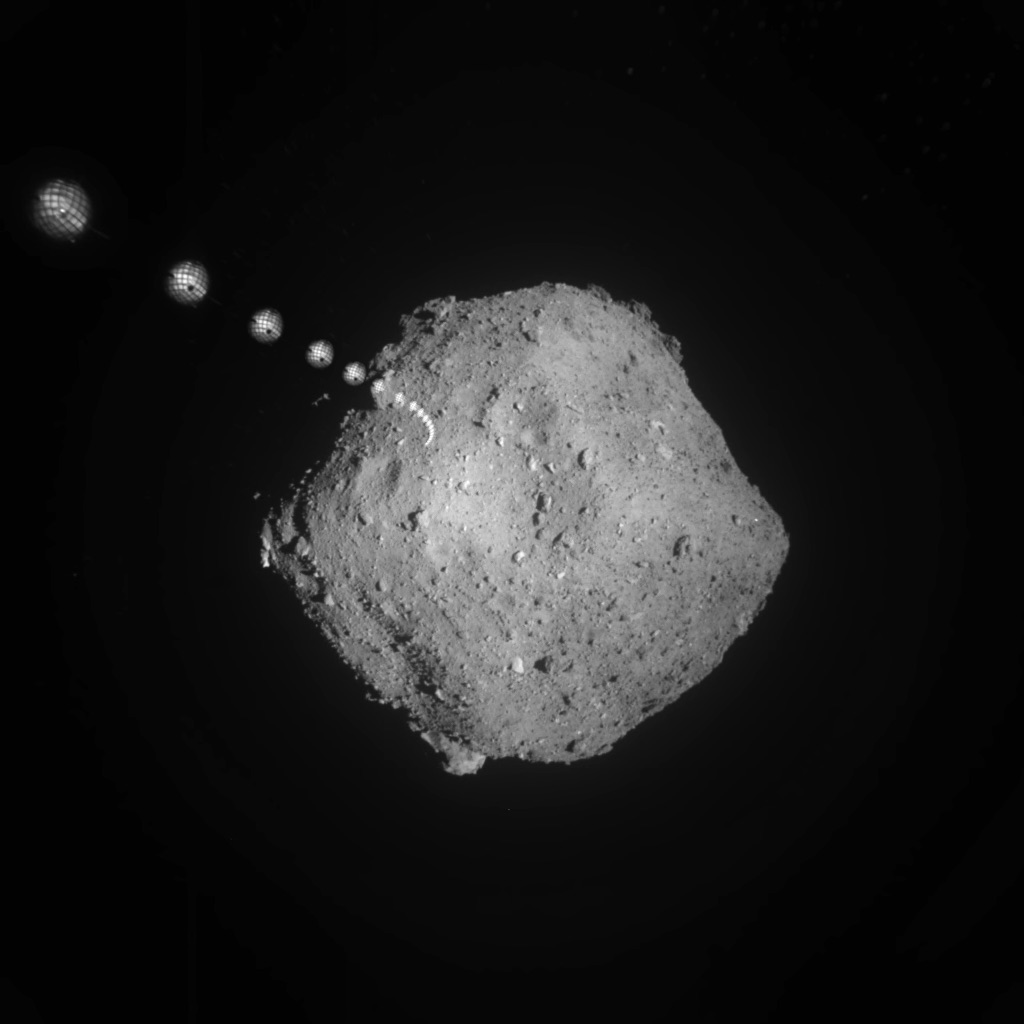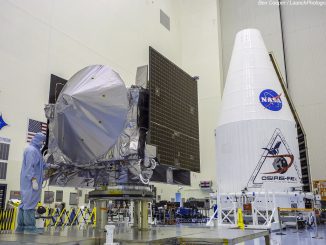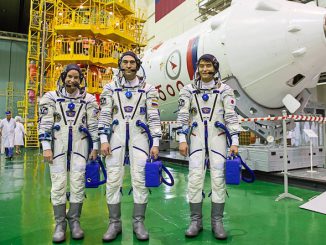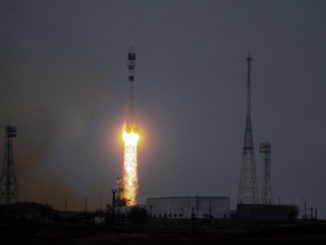
Japan’s Hayabusa 2 spacecraft deployed two target markers Monday above asteroid Ryugu in a rehearsal for the release of the mission’s final landing robot next month.
The robotic asteroid explorer released the two 4-inch (10-centimeter) ball-shaped markers seven minutes apart Monday, after the Hayabusa 2 spacecraft descended to a distance of about 3,300 feet (1 kilometer) from Ryugu.
The Japan Aerospace Exploration Agency, or JAXA, released a pair of images showing the target markers, each covered in a reflective film, after their release from Hayabusa 2. The target markers are unpowered and entirely passive objects designed as navigation aids for Hayabusa 2 around the asteroid.
With both target markers away, Hayabusa 2 fired its thrusters to begin an ascent back to a home position farther from the asteroid. Ground teams are in the final stages of planning another descent toward Ryugu in October, during which Hayabusa 2 will deploy the last of four landing robots to the asteroid’s surface.
“We released two target markers from an altitude of about 1 kilometer, and these images were just released,” said Makoto Yoshikawa, Hayabusa 2’s mission manager at JAXA. “The purpose of this release is a rehearsal of the release of the MINERVA-II-2 small rover next month.”
Hayabusa 2’s cameras will track the movement of the two navigation aids as they fly in space around Ryugu over the next several days. Scientists expect Ryugu’s tenuous gravity will pull the target markers to the asteroid’s surface within a week.
“We can observe the target marker’s orbit around Ryugu and we can then determine the gravity field of Ryugu in detail, so this is a new operation,” Yoshikawa said Tuesday in a press briefing at the European Planetary Science Congress.
Image of the first target marker (TM) separation, TM-E!
Separation time: 2019/9/17 at 01:17 JST
Altitude: 1kmThis is an overlay of images taken every 4s (for ~1min) as the spacecraft ascends at 11cm/s. TM descent speed is still almost zero. (📷 JAXA, Chiba Inst. Tech & collab) pic.twitter.com/FXM7Nda0vx
— HAYABUSA2@JAXA (@haya2e_jaxa) September 17, 2019
Hayabusa 2 is in the final phase of its science campaign at asteroid Ryugu, where it arrived in June 2018 after a three-and-a-half year journey from Earth. The spacecraft has conducted two touch-and-go landings on Ryugu — one in February and another in July — to gather pristine asteroid samples for return to Earth.
Last year, Hayabusa 2 deployed three mobile landers to hop around Ryugu. Two MINERVA-II landers, developed in Japan, and a larger robot named MASCOT managed by the German and French space agencies beamed back images and scientific data from Ryugu’s surface.
One more lander remains in Hayabusa 2’s toolkit.
The MINERVA-II-2 mobile lander was developed by a consortium of Japanese universities as a piggyback payload for Hayabusa 2. The robot is smaller than a soccer ball, but carries mechanisms to allow it to move around the asteroid, along with a camera, a thermometer, photodiode, and an accelerometer.
Hayabusa 2 is scheduled to depart Ryugu by the end of this year using plasma engines, aiming for a return to Earth in December 2020, when the craft will release a parachute-equipped re-entry capsule to land in Australia.
Scientists will retrieve the asteroid specimens for detailed analysis.
“If we have 0.1 grams (of material), we can do all the sample analysis, but we hope we will have much more,” Yoshikawa said.
“We want to study the organic matter on Ryugu because we want to know the origin of life on the Earth, and we think Ryugu has original matter that became life,” he said. “So our main purpose is analysis of the organic matter on the surface of Ryugu.”
Email the author.
Follow Stephen Clark on Twitter: @StephenClark1.



